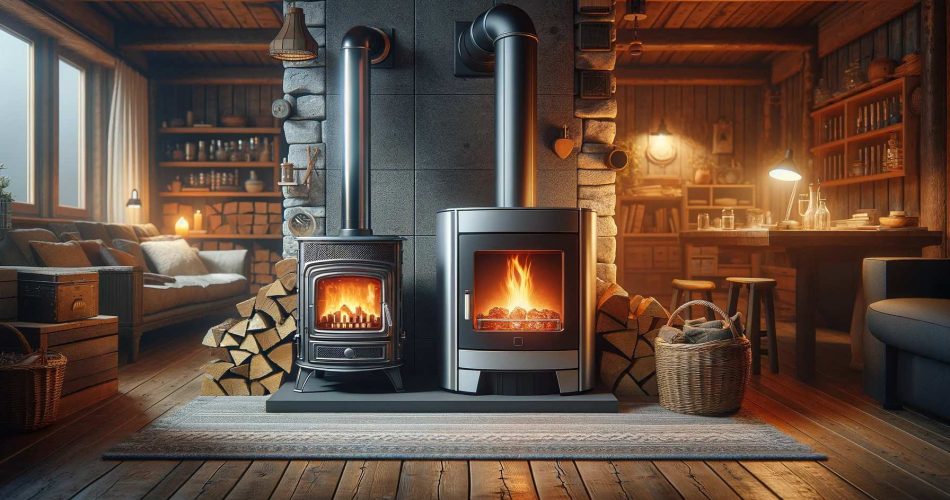Understand the differences between wood stoves and pellet stoves
Whether it’s a cozy cabin in the woods or the living room where your family relaxes in the evenings, wood-burning stoves offer a warm, inviting, and more sustainable form of heating that many homeowners are turning to today.
You save on utility costs and enjoy more homely warmth that brightens up even the coldest winter nights.
However, many homeowners remain confused about whether to go for a firewood stove or a pellet stove. Both stove designs offer advantages and drawbacks that make them better suited for specific situations.
Here’s an in-depth comparison to help you decide which one suits your needs.
Here is a quick table if you don’t want to read the whole article.
| Feature | Wood Stoves | Pellet Stoves |
|---|---|---|
| Efficiency | Varies with wood type; less efficient than pellet stoves; produces more ash and debris. | Generally more efficient; controlled combustion; produces less waste. |
| Convenience | Manual operation; suitable for off-grid use. | Automated features; preset temperature control; less manual intervention required. |
| Cost | Lower initial cost; potential for higher operational costs depending on firewood availability. | Higher installation cost; more cost-effective over time in areas with affordable pellets. |
| Maintenance | More frequent cleaning is required; simpler, less costly repairs. | Less frequent cleaning; potentially higher repair costs due to mechanical parts. |
| Usability | Traditional operations might appeal to users familiar with wood burning. | More user-friendly with automated controls and interfaces. |
| Durability | Typically, it has a longer lifespan due to a more straightforward design. | It may have a shorter lifespan due to mechanical and electrical components. |
| Environmental Impact | Carbon-neutral if sourced sustainably; higher emissions than pellet stoves. | It has a low carbon footprint, utilizes recycled materials, and burns cleaner. |
| Safety Considerations | Higher risk of chimney fires; requires regular maintenance for safe operation. | Electrical malfunction risks; safer in terms of fire hazards. |
| Installation Requirements | Needs a well-insulated chimney more demanding installation. | It requires electricity, can vent horizontally, and is easier to install in diverse settings. |
| Fuel Availability and Types | Depending on local availability, various wood types affect performance. | Pellets are widely available in urban areas; they are uniform and easy to store. |
| Aesthetic and Cultural Aspects | Traditional, rustic appeal; visible flames and crackling sound. | Modern design; compact; less traditional aesthetic. |
| Long-Term Costs | Potentially higher long-term costs depend on firewood access. | Lower operational costs in the long run; higher upfront costs. |
| Regulatory Considerations | Must comply with local emissions and installation regulations. | Same as wood stoves, with additional electrical standards compliance. |
| Technological Advances | Advances in combustion technology; more efficient and cleaner burning. | Innovations in control systems; remote operation capabilities. |
| User Reviews and Experiences | Traditional user experience is preferred by those accustomed to wood burning. | Favorable reviews for ease of use and automated features. |
Comparing Wood and Pellet Stoves: Key Features
Efficiency
Several factors come into play when comparing the efficiency of wood and pellet stoves. You have to consider stove design, the ratio of stove-to-room size, control over combustion, type and quality of the firewood or pellets, etc.
However, pellet stoves generally deliver more efficiency compared to stoves that use traditional firewood. Combustion control is easier because the thermostat and hopper ensure optimal use of the pellets. On the other hand, firewood stoves require you to start, feed, and stoke the fire manually.
Pellet stoves are also more efficient in generating waste. You’ll deal with less ash and debris with pellet stoves, while wood stoves leave behind more cinders, ash, and rubble to clean.
However, people who don’t mind stoking the stove and actively feeding the fire may draw as much efficiency from wood stoves, too.
Convenience
Pellet stoves prove more convenient in sub-urban or semi-urban settings thanks to their automated features.
For instance, you can preset the desired temperature on a pellet stove and walk away. The stove will self-regulate and maintain this specified level of heat till it runs out of pellets. Pellet stoves also come with a hopper that holds and feeds the pellets to the fire.
So you don’t have to keep tending to the fire. This convenience plays a significant role in buyers when comparing wood and pellet stoves for home use.
Wood pellets are also easier to source, store, and handle in sub-urban areas. You can buy them in bags from the store and keep them anywhere in the house. With firewood, you’ll need to store them away from moisture and carry them indoors whenever the stove needs refueling.
However, there are situations where a wood stove may prove more convenient. For example, most of the pellet stove’s automated features rely on electricity to run. So, if you’re in the backcountry with no access to electricity, a wood stove may prove more practical and convenient.
Cost
Wood stoves can be highly cost-effective heating systems if you enjoy access to affordable firewood. Wood stoves usually come with cheaper installation, while pellet stoves cost more to set up because of their electrical connections, vents, and placement.
Repairs are also more straightforward with a wood stove, which implies less maintenance costs. Pellet stoves contain more mechanical and electrical components that demand more expertise in repairs if any part stops functioning.
However, we’re mostly talking about the monetary costs of purchase, upkeep, and repairs here. Wood stoves are more labor-intensive and require more manual work from the owner. So, these stoves aren’t “cheap” either if you consider labor and energy as costs in operating them.
Also, access to firewood is a massive factor in costs when comparing wood stoves to pellet stoves. Homeowners who enjoy access to their own firewood or can source affordable firewood will find wood stoves more budget-friendly. However, if you live in an area where firewood is expensive (sourcing, transportation, storage, etc.), pellets will prove more cost-effective in the long run.
Maintenance
General maintenance is more straightforward with pellet stoves compared to firewood stoves.
Regular cleaning is where you notice the most difference between the two stoves.
Pellets are made from a combination of recycled wood particles (mostly sawdust that’s compressed and held together by lignin). Their composition is consistent throughout, and there’s almost no moisture in between. So, the whole pellet burns through, leaving less ash and residue.
On the other hand, firewood carries inconsistent composition (Eg. the bark’s texture is different from the sap and the heartwood). They also retain more moisture if stored outdoors. Plus, wood carries soil, sand, and minerals in different compositions. As a result, they don’t combust fully, leaving behind more debris and ash.
So, you end up cleaning and clearing the insides of a wood stove more frequently.
However, a pellet stove with damaged electrical parts will require more intensive repairs compared to wood stoves. So, consider repair risks when you compare ease of maintenance between wood and pellet stoves.
Usability
With household equipment, usability can include the ease of operation and the learning curve involved when first introduced.
With heating stoves, usability simply comes down to the individual’s orientation and preference. So, you can rely on personal taste and instinct when comparing wood and pellet stoves in terms of usability.
Pellet stoves often include an interface or control panel that allows you to ignite the fire or specify the temperature. The stove’s hopper holds all the pellets required for a heating session, and it continues feeding itself till the hopper empties. These convenient features make pellet stoves more “usable” for most people.
However, if you’re used to making and tending your own fire, the manual nature of a wood stove may feel more usable for you.
Durability
Your stove’s durability comes down to the maintenance practices, upkeep, quality, and build of the unit. However, in most cases, it’s typical for wood stoves to last longer than pellet stoves.
Wood stoves come with simple designs that do not have a lot of moving parts. It holds and burns the firewood, providing warmth to the room while sending the smoke outdoors via the chimney. This simple mechanism means allows less risk of damage or dysfunction. Also, repairs are relatively simple and easy, even if your wood stove experiences some mishaps.
Of course, you must ensure that you clean and keep up with maintenance measures regularly. But there’s no doubt it will last you for decades if used correctly and cared for diligently. It’s the same reason why you may see a 19th-century stove that still works even though it’s been around for generations.
Pellet stoves contain a considerable level of mechanical parts and electrical functions. The interface, buttons, hopper, and self-feeding design all rely on the electrical and mechanical elements working together. If even one of these functions stops working, the whole unit becomes useless. Over time, any damage or defects it develops will shorten the lifespan of the unit.
Sustainability
There’s no doubt that firewood and wood pellets offer environmentally safer alternatives compared to fossil fuels and gas stoves. However, the issue of which wood fuel is more sustainable is not as obvious.
Many governments consider firewood to be a carbon-neutral fuel as long as trees continue being replanted. But large-scale burning of firewood will easily exceed the decades it takes for forests to recover. Meanwhile, manufacturers create pellets from the residues created during woodwork and wood processing. Sawdust and other debris from woodworking get processed into wood pellets. So, pellets have the advantage of being identified as recycled fuel instead of a natural fuel like firewood.
The Environmental Protection Agency (EPA) imposes specific limits on emissions made by these stoves regardless of whether they use split wood (firewood) or pellets. No heating stove can emit particulate matter (PM) in excess of 4.5 grams calculated per hour during combustion.
More importantly, heating systems that follow the EPA’s stricter guidelines earn an EPA-approved sticker. These units emit even less particulate matter (PM), with less than 2.5 grams of emissions released every hour.
Look for this EPA-endorsed label before purchasing your heating system, regardless of fuel type. Check to see if the models you’re considering meet these EPA requirements when comparing wood and pellet stoves.
Heating and Warmth
The heating capability of your stove will depend on the individual unit’s capacity. Most units will come with a BTU level and a square foot marker that indicates the space it can heat up.
British Thermal Units (BTU) is the measure of how much your fuel (pellet or wood) can heat up the surrounding areas. For example, a stove with 32,000 BTUs may be able to warm up about 1000 sq. ft. of space. So, your stove’s heating capacity should depend on the area of your home or the space you wish to heat up.
Pellet and wood stoves can range from models as small as 9,000 BTUs to over 90,000 BTUs, depending on the build and design. So, make a rough measurement of your home or living space and purchase a model that offers the relevant BTU capacity.
Pellet stoves often provide a more uniform and consistent temperature. That’s because the pellets get fed into the fire in a controlled and consistent manner. And the heat is easier to control, too, thanks to its control panel and interface.
However, many homeowners agree that the cozy warmth of real firewood is simply incomparable. Yes, there’s more manual work, feeding, and cleaning involved. However, they agree that the traditional warmth and comfort of fire from chopped wood is superior to processed pellets.
Environmental Impact
Wood stoves and pellet stoves differ significantly in their environmental impact. Pellet stoves utilize biomass pellets made from compressed organic matter, often recycled wood waste like sawdust. The manufacturing process of pellets is energy-intensive, but the pellets burn cleaner than traditional firewood, producing fewer pollutants and a lower carbon footprint. In contrast, wood stoves burn firewood, which, when sourced sustainably (i.e., from well-managed forests), can be considered a renewable resource. However, the combustion of firewood typically releases more particulate matter and carbon monoxide. The efficiency of wood stoves can vary greatly, depending on the wood’s moisture content and stove design.
Safety Considerations
Safety is a critical aspect when using any heating appliance. Wood stoves, if not properly maintained, can pose a higher risk of chimney fires due to creosote buildup. It’s crucial to regularly clean and inspect the chimney and stovepipe. Pellet stoves, while generally safer, have their own risks, primarily electrical malfunctions or auger (the device that feeds pellets into the burn pot) blockages. Both types of stoves should be installed following local regulations and manufacturer guidelines, ensuring adequate ventilation and clearance from combustible materials.
Installation Requirements
The installation of wood and pellet stoves must comply with specific requirements to ensure safe and efficient operation. Pellet stoves usually need an electrical connection to power the auger, the fan, and sometimes an igniter. They can vent horizontally, reducing the need for a traditional chimney, but still require proper ventilation to expel combustion gases. Wood stoves typically require a well-insulated chimney, which must extend beyond the roofline according to local codes. The hearth or the floor beneath and surrounding the stove must be fire-resistant, typically made of stone, ceramic, or metal.
Availability and Types of Fuel
The availability and cost of firewood and pellets can vary widely depending on the region. In rural areas with abundant wood resources, firewood might be more cost-effective and readily available. In contrast, urban and suburban areas might have better access to pellets, which are compact and uniform, making them easier to store and handle. The type of wood used for firewood also affects its efficiency and burn quality – hardwoods like oak and maple burn slower and hotter than softwoods like pine.
Aesthetic and Cultural Aspects
Aesthetically, wood stoves offer a traditional, rustic appeal that many find appealing, creating a cozy ambiance with the visible flames and the sound of crackling wood. They can become the centerpiece of a room, adding to the home’s overall charm. Pellet stoves, on the other hand, often have a more modern design and might include features like glass fronts to view the fire. They tend to be more compact and can fit into smaller spaces, but they lack wood stoves’ traditional look and feel.
Long-Term Costs
The long-term costs of wood and pellet stoves encompass installation, fuel, maintenance, and potential repairs. Wood stoves might have a lower initial cost but can be more expensive to operate, especially if firewood is not readily available at a low cost. Pellet stoves often have higher upfront costs due to the need for electrical installation and a proper venting system. However, they can be more cost-effective in the long run, particularly in areas where pellets are cheap and easy to source. Maintenance costs for pellet stoves can be higher, given their more complex mechanical and electrical components.
Regulatory Considerations
Regulations surrounding the installation and operation of wood and pellet stoves can vary. Many regions have strict guidelines on emissions, requiring EPA-certified stoves that meet specific particulate emission standards. Local building codes also dictate installation specifics, like chimney height and hearth construction. It’s essential for homeowners to familiarize themselves with these regulations to ensure compliance and safety.
Technological Advances
Recent technological advancements in stove design have improved wood and pellet stoves’ efficiency, safety, and user-friendliness. Modern wood stoves often include features like secondary combustion systems, which burn off additional gases and particulates, significantly reducing emissions. Pellet stoves have seen advances in electronic control systems, allowing for more precise temperature control and automated operation, including remote monitoring and control via smartphone apps.
User Reviews and Experiences
User reviews and experiences can provide practical insights into the everyday use of wood and pellet stoves. Reviews often highlight specific models’ reliability, ease of use, and maintenance requirements. They can also offer valuable tips on fuel sourcing and storage, as well as real-world information on the cost of operation. However, it’s important to consider that these reviews are subjective and may reflect individual preferences and local conditions.
Closing Note
Comparing wood and pellet stoves involves a lot of factors ranging from budget and living situations to convenience and personal preferences.
A pellet stove may prove more convenient for households with reliable electricity and affordable access to pellets. However, cabins or homes with easy access to firewood may enjoy the superior, natural warmth that wood stoves offer pellet stoves.




Comments